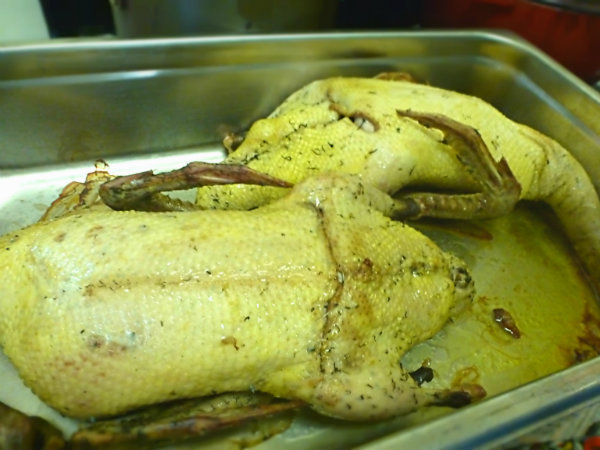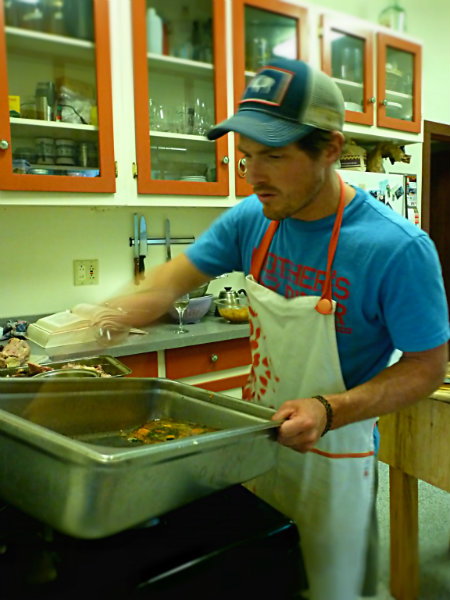
Last night we cooked up the two ducklings we harvested a couple months back. It was quite a day in the kitchen. First, I baked a couple loaves of sourdough bread. Then I made a delicious soup of zucchini, potato, kale, chard, onions and garlic, all harvested from our garden, and a chunk of demi-glace to give it a delicious kick. Then I prepped some pie crusts. After all that, I set in on making pato a la Sevillana (duck with olive in sherry sauce).
I found the recipe in Penelope Casas’ indispensable cookbook, The Foods and Wines of Spain. [Follow the link for info, but please purchase the book from a local bookseller.] While our ducklings were from the backyard and not from the marshlands of the Guadalquivir River near Sevilla, it was, as Ms. Casas writes, an elegant meal that was very popular with our guests: Katherine’s parents, her sister, my father and our housemate Austen.
Upon slaughtering and dressing the ducklings a few months ago, I was concerned they might not have much meat on them. They looked kind of pip-squeaky and weak. With that in mind, and considering the number of guests we were having over, we decided we’d cook up both ducklings in hopes that there would be enough meat to go around.

Following Ms. Casas’ recipe, we stuck a couple garlic cloves and onion slices in the birds’ cavities and trussed them. In reading up on as many duck recipes as we could find in our cookbook collection, we learned that inserting some veggies inside the ducks helps absorb some potentially unappetizing flavors. Don’t know if that’s an old wives tale or not, but we did it anyway. I put the ducklings in a large hotel pan, covered it with tin foil, and roasted them at 350 degrees for an hour while we took the dogs for a walk.

After roasting the birds, I removed them from the pan, poured off the fat — which I like to call “culinary gold”: there are few cooking fats more flavorful than duck fat — and deglazed the pan with some white wine and reserved that liquid. I broke the ducklings down to wings, legs and breasts, and placed them in a casserole dish. While our guests noshed on cantaloupe wrapped in prosciutto cotto and local cheeses, I heated some olive oil in the deglazed hotel pan, tossed in a chopped onion plus a couple minced garlic cloves and sautéed them until the onions wilted. I then added a half cup of dry sherry, some chicken broth, thinly sliced carrots, parsley, thyme, a bay leaf, some peppercorns, salt to taste and the deglazed pan jus, and simmered it all for about five minutes. I poured the resulting sauce over the ducks, covered the casserole dish with aluminum foil and put it back in the 350 degree oven for 45 minutes.

Rather than strain the braising sauce, I served the duck straight from the casserole dish, knowing everybody would want to slather sauce all over their polenta and sop it up with a scarpetta. It was delicious! The duck was rich, aromatic, earthy, slightly sweet, slightly floral, a perfect balance to the freely-flowing wine, drams of homemade limoncello and spirited discussion, which you can depend on when you get a bunch of Italians around a table.

